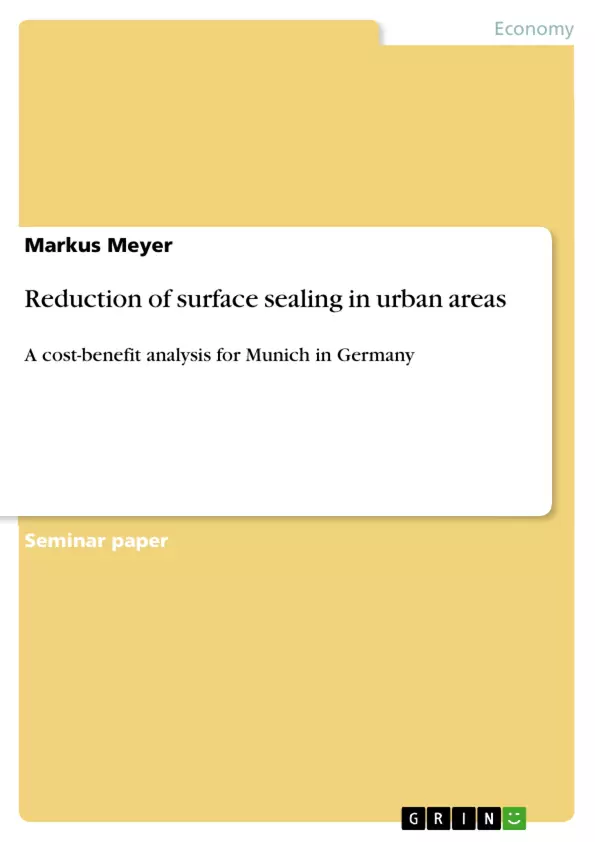This cost-benefit analysis estimates the net benefit of desealing through the promotion of permeable pavement. The area of study is the city of Munich. The city of Munich subsidizes through a program surface desealing by consumer subsidies for permeable pavement that should replace currently impermeable paved areas. The consumer subsidies should result in a decline of the impermeable paved area of 15 percent from 1996 to 2020. The major cost component is the marginal excess tax burden that occurs from the taxes that have to be raised to finance the subsidies. The major benefit is the reduction of the flooding risk due to the higher infiltration of water into the soil. The payback of the project is estimated for 2077. The net benefits per m² permeable pavement are positive in comparison with impermeable pavement. The main reason for the late payback of the project are the high subsidies paid. A scenario analysis shows that the lowering of the consumer subsidies per m² of permeable pavement will result in a payback of the project in 2036.
Inhaltsverzeichnis (Table of Contents)
- 1. Introduction
- 1.1 Background
- 1.2 Purpose of the investigation
- 1.3 Area of study
- 2. Methods
- 2.1 Theoretical considerations
- 2.1.1 Alternative projects
- 2.1.2 Standings and impact categories
- 2.1.3 Impact categories in theory
- 2.2 Empirical implementation
- 2.2.1 General assumptions
- 2.2.2 Costs
- 2.2.3 Benefits
- 2.2.4 Comparison of costs and benefits in time
- 2.3 Sensitivity analysis
- 2.1 Theoretical considerations
- 3. Results
- 3.1 Baseline scenario
- 3.1.1 General results
- 3.1.2 Sensitivity analysis
- 3.2 Policy optimization scenario
- 3.1 Baseline scenario
- 4. Discussion
Zielsetzung und Themenschwerpunkte (Objectives and Key Themes)
This cost-benefit analysis aims to estimate the net benefit of reducing surface sealing in Munich, Germany, by promoting permeable pavement. The study focuses on the economic viability of a city-subsidized program encouraging the replacement of impermeable paved areas with permeable alternatives.
- Economic feasibility of permeable pavement implementation
- Assessment of the costs associated with subsidies for permeable pavement
- Evaluation of the benefits of reduced flooding risk through increased water infiltration
- Analysis of the time frame for project payback
- Sensitivity analysis of different subsidy levels
Zusammenfassung der Kapitel (Chapter Summaries)
Chapter 1: Introduction provides background information on surface sealing, its negative impacts, and the context of the study in Munich. It highlights the problem of urban sprawl and the increasing degree of imperviousness in urban areas.
Chapter 2: Methods details the theoretical framework and empirical implementation of the cost-benefit analysis. This includes a discussion of alternative projects, impact categories, cost and benefit estimations, and a sensitivity analysis.
Chapter 3: Results presents the findings of the cost-benefit analysis, including the results for a baseline scenario and a policy optimization scenario, examining the general results and sensitivity analysis of the baseline scenario.
Schlüsselwörter (Keywords)
Surface sealing, permeable pavement, urban sprawl, cost-benefit analysis, flooding risk, water infiltration, subsidies, Munich, Germany, economic feasibility, policy optimization.
- Citar trabajo
- Markus Meyer (Autor), 2011, Reduction of surface sealing in urban areas, Múnich, GRIN Verlag, https://www.grin.com/document/183038



